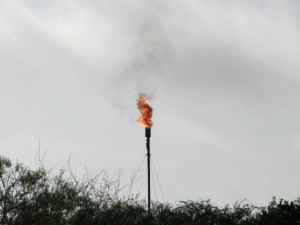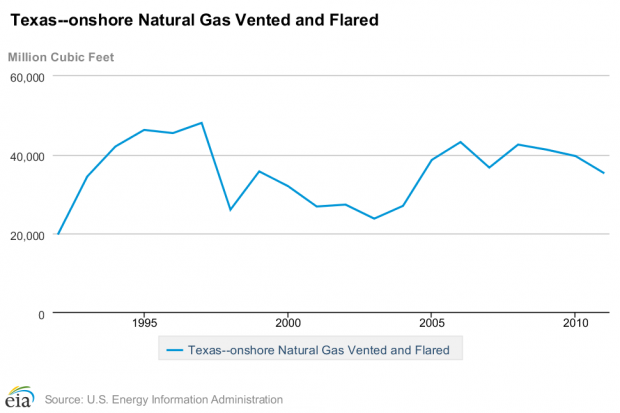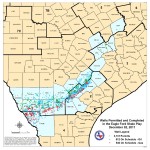One Downside of Oil Drilling? Wasted Gas

Flaring gas at well site in DeWitt County
As the fracking drilling boom continues in Texas and other states, a shift has taken place. While the beginning of the surge saw a rush for natural gas, in recent years the focus has moved to oil. And in the process, a lot of natural gas is being wasted. Billions of dollars worth, enough to power an entire nation.
When an oil well is drilled, it can also produce methane. But in drilling areas like the Eagle Ford Shale in Texas and the Bakken Shale in North Dakota, methane isn’t what drillers are after. One option is to simply vent it, releasing it directly into the atmosphere. Another is to “flare” it, combusting the methane instead. There’s enough flaring and drilling going on that you can see it from space.
“Flaring is infinitely more preferable than just venting those emissions into the atmosphere,” Drew Nelson, Manager of Special Projects for the Environmental Defense Fund, says. “Methane is much potent than carbon dioxide.” If methane were released directly in the air, it would have a much more detrimental climate effect. By burning the methane, it converts to carbon dioxide. “Which is still a greenhouse gas,” Nelson says, “but one molecule of methane is anywhere from 24 to a hundred times more potent than one molecule of carbon dioxide, depending on the time frame you’re looking at.”
But why not just collect and sell the gas?
The problem is infrastructure to get the gas produced by oil drilling to where it needs to go. “The necessary natural gas infrastructure—gathering pipelines, processing plants, transportation pipelines—surrounding the Bakken shale has not expanded at the same pace, effectively stranding the natural gas that is produced during oil production,” the Energy Information Administration (EIA) wrote in an analysis in 2011. Nelson of EDF says the same applies in the Eagle Ford formation. There isn’t enough existing pipeline infrastructure to move the gas from the well to where it can be processed and sold. “And building those pipelines is not cheap or easy,” Nelson says. “So, often times, it requires some sort of regulatory incentive.” Not to mention, oil drillers stand to make a lot more from selling oil than selling gas.

Chart by EIA
Flaring in Texas had more or less leveled off by 2011, according to the federal Energy Information Administration.
In Texas, all drillers can flare for ten days after drilling a well. They can then apply to extend flaring in 45-day increments, for a total period up to six months after drilling a well. To get an extension, the driller must demonstrate that they’re trying to get infrastructure in place to collect the gas instead of burning it, according to the Railroad Commission, which oversees drilling in the state. The commission says on its website that drillers are usually waiting for a pipeline to move the gas, or negotiating with landowners.

Chart by EIA
Flaring in Texas had more or less leveled off by 2011, according to the federal Energy Information Administration.
And the number of permits issued by the state for flaring has risen dramatically, from just 107 in 2008 to nearly 2,000 in 2012. (That also speaks to the rise in oil drilling in the state, as flaring permits are typically not issued for natural gas wells.) While the overall amount of gas flared in Texas is lower than North Dakota or Wyoming, the state is the third-largest contributor to flaring in the country. It burnt off 35,248 million cubic feet of gas in 2011, the most recent year of available data. That’s about one percent of the state’s overall annual natural gas consumption.
For now, many drillers are simply burning money. “Any molecule of gas that you’re flaring is a dollar bill you’re flaring as well,” Nelson says. “It is a precious waste of this American resource.” If the gas could be captured and sold, drillers could earn more profits, and less carbon dioxide, less light pollution would occur, and domestic supplies of natural gas would be more robust.
North Dakota is trying to entice drillers to flare less natural gas. Under proposed rules, the state could give temporary tax incentives to companies that have systems to avoid at least 75 percent of flaring. Overall, the amount of natural gas vented or flared in the U.S. is consistently down since the 1970s, even since the arrival of the latest drilling boom.

